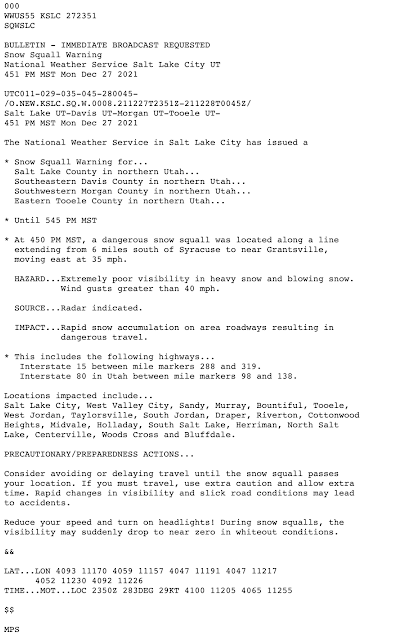The term snow squall has recently and forcefully entered the vernacular of Utahns as a series of strong cold fronts with intense bursts of snow and wind have moved through northern Utah over the past few days. The most recent was yesterday afternoon.
 |
| Credit: Andrea Steenburgh |
It promoted the issuance of snow squall warnings by the National Weather Service.
Snow squalls are not new phenomenon. The term is commonly used in the northeast United States where snow squalls can be produced by fronts, lake-effect storms, and other phenomena. Here in Utah, it has sometimes been used to describe bursts of snow associated with lake-effect storms, but less commonly to describe bursts of snow associated with cold fronts, as occurred yesterday. Why the change?
First, let's define snow squall. Per the National Weather Service Glossary a snow squall is "an intense, but limited duration, period of moderate to heavy snowfall, accompanied by strong, gusty surface winds and possibly lightning." Technically, the criteria for the issuance of a snow squall warning include visibility of less than a quarter of a mile, subfreezing ground/road temperatures, expected duration of less than 60 minutes, and dangerous and life-threatening conditions. Such squalls can be a major hazard for road travel and aviation, but also for anyone who may be outdoors.
Banacos et al. (2020) describe the development of the NWS snow squall warning. The NWS used to issue special weather statements for snow squalls, but found they did not result in the same level of urgency as a warning. During the winter of 2017-18 the NWS introduced and did an operational demonstration of snow squall warnings at six weather forecast offices. It was then operationalized across the United States in the winter of 2018–19.
Utah cold fronts are sometimes accompanied by snow-squall conditions, including rapid and dramatic cooling to sub-freezing temperatures, heavy snowfall, high winds, and in some cases lightning. Although the term snow squall hasn't previously been used widely to describe such conditions, it makes sense to adopt this change now and issue such warnings to better highlight when hazardous weather conditions will occur. The warnings can also be used for lake-effect storms and other phenomena that can produce snow-squall conditions.


I was trained to encode a squall when the wind of at least 15kt doubled in strength and held that value for a time, with a capital Q: 32015Q35kt instead of an instantaneous G35. IOW a squall is a wind phenomenon, a snow-squall is that, accompanied by heavy snow. Yes? (I love your shots from the Avenues, where I used to live.)
ReplyDelete